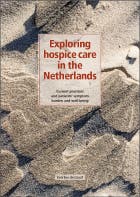Everlien Graaf
Exploring hospice care in the Netherlands Current practices and patients’ symptom burden and well-being

- Datum
- (Co) promotoren
- 15-03-2018
- prof.dr. S.C.C. Teunissen, dr. A. de Graeff
Samenvatting
Hospice care aims to optimize the quality of life of patients with a life-limiting illness and their families. Hospices were initiated to ameliorate and de-medicalize care for the dying. Patients with a life expectancy of <3 months have access to hospice care, a large and heterogenic population. The differences in hospice care should fit the needs of patients admitted. The twofolded aim of this thesis was 1) to explore hospice care in the Netherlands and 2) to gain insight into hospice patients’ symptoms and well-being. Part I Exploration of hospice care in the Netherlands Exploration of hospice care resulted in six core characteristics of professional-driven hospices: 1) admittance of patients <3 months estimated life expectancy; 2) last resort, respite, crisis and day care; 3) multidimensional care; 4) professionals and trained volunteers. 5) home-like, respect and autonomy; 6) community services, education and research. The operationalization differs largely between hospices. Multidimensional care was not always identifiable in patient records, however its importance was underpinned by caregivers. Most attention was paid to the physical dimension; the social and spiritual dimensions were less described. Interdisciplinary collaboration, methods of clinical reasoning, and supportive structures promote multidimensional care. The hospice assist at home (HaHo) service, aims to enable patients to die at their preferred location. The preferred place of death was known for 122/130 patients, of whom 91% died at their preferred location. Part II Symptoms and well-being of hospice patients The influence of age on hospice patients’ symptom burden was relatively small. Pain had a significant higher prevalence and severity scores in patients <65 than in older patients. The prevalence of anorexia was highest for patients aged ≥85. At admission, fatigue, depressed mood, and anorexia explained 49% of the variance of well-being. During admission, fatigue, pain, anorexia, dyspnea, depressed mood, and anxiety were independent predictors of well-being. Both models were corrected for age, gender, cancer diagnosis, marital status, and survival. Agreement between patients’ and nurse’s assessments of symptom intensity was studied in the first three weeks after admission. Complete concordance (CC) was >60% for nausea, anxiety, and dysphagia and <40% dry mouth, and constipation. Nurses predominantly underestimated symptom intensity. Agreement beyond chance (ABC) was moderate for dyspnea (Kappa>0.6) and slight for anxiety (Kappa<0.2). Both CC and ABC did not improve over time. Conclusion The implementation of the hospice concept in the Netherlands is still work in progress. The development of services, staffing and competencies is necessary to integrate appropriate multidimensional care. The use of the Utrecht Symptom Diary supports vulnerable patients of all ages receiving hospice care. Implementation of a stepwise approach for systematic assessment and monitoring promotes multidimensional hospice care. Caregivers should be aware tendency to underestimate symptom intensity.
